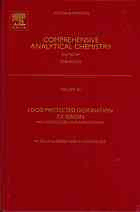
Food protected designation of origin: methodologies and applications PDF
Preview Food protected designation of origin: methodologies and applications
Food Protected Designation of Origin Methodologies and Applications Comprehensive Analytical Chemistry Volume 60 ADVISORY BOARD Joseph A. Caruso University of Cincinnati, Cincinnati, OH, USA Hendrik Emons Joint Research Centre, Geel, Belgium Gary Hieftje Indiana University, Bloomington, IN, USA Kiyokatsu Jinno Toyohashi University of Technology, Toyohashi, Japan Uwe Karst University of Mu¨nster, Mu¨nster, Germany Gyro¨gy Marko-Varga AstraZeneca, Lund, Sweden Janusz Pawliszyn University of Waterloo, Waterloo, Ont., Canada Susan Richardson US Environmental Protection Agency, Athens, GA, USA Food Protected Designation of Origin Methodologies and Applications Comprehensive Analytical Chemistry Volume 60 Miguel de la Guardia and Ana Gonza´lvez Department of Analytical Chemistry, University of Valencia, Valencia, Spain AMSTERDAM (cid:129) BOSTON (cid:129) HEIDELBERG (cid:129) LONDON (cid:129) NEW YORK (cid:129) OXFORD PARIS (cid:129) SAN DIEGO (cid:129) SAN FRANCISCO (cid:129) SINGAPORE (cid:129) SYDNEY (cid:129) TOKYO Elsevier TheBoulevard,LangfordLane,Kidlington,OxfordOX51GB,UK Radarweg29,POBox211,1000AEAmsterdam,TheNetherlands Firstedition2013 Copyright©2013ElsevierB.V.Allrightsreserved. Nopartofthispublicationmaybereproduced,storedinaretrievalsystemortransmittedin anyformorbyanymeanselectronic,mechanical,photocopying,recordingorotherwisewithout thepriorwrittenpermissionofthepublisher PermissionsmaybesoughtdirectlyfromElsevier’sScience&TechnologyRightsDepartment inOxford,UK:phone(+44)(0)1865843830;fax(+44)(0)1865853333;email: permissions@elsevier.com.Alternativelyyoucansubmityourrequestonlinebyvisitingthe Elsevierwebsiteathttp://elsevier.com/locate/permissions,andselecting ObtainingpermissiontouseElseviermaterial Notice Noresponsibilityisassumedbythepublisherforanyinjuryand/ordamagetopersonsorproperty asamatterofproductsliability,negligenceorotherwise,orfromanyuseoroperationofany methods,products,instructionsorideascontainedinthematerialherein.Becauseofrapid advancesinthemedicalsciences,inparticular,independentverificationofdiagnosesanddrug dosagesshouldbemade BritishLibraryCataloguinginPublicationData AcatalogrecordforthisbookisavailablefromtheBritishLibrary LibraryofCongressCataloging-in-PublicationData AcataloguerecordforthisbookisavailablefromtheLibraryofCongress ISBN:978-0-444-59562-1 ISSN:0166-526X ForinformationonallElsevierpublications visitourwebsiteatstore.elsevier.com PrintedandboundinGreatBritain 13 14 15 16 17 10 9 8 7 6 5 4 3 2 1 Contents ContributorstoVolume60 xvii Abbreviations xxi SeriesEditorsPreface xxix Preface xxxi Part I The Social and Legal Framework of PDO 1. Legal Aspects of Food Protected Designations 3 MarinaCarceaandFrancescaMelini 1. Introduction 3 2. A BriefHistoryoftheAdoptionofEuropean Legislation onPDOs,PGIandTSGs 4 3. PDO,PGIandTSG:LegalDefinition,Labellingand Establishment ofLogos.OtherFoodQuality-LinkedLogos inEurope 7 3.1. LegalDefinition 7 3.2. LabellingofPDOs, PGIsandTSGs 9 3.3. Protectionof GeographicalIndications inthe WineSector 11 3.4. OtherFood Quality-LinkedLogosin Europe 14 4. Legal ProcedureforRegistrationofProtectedFoodsinEurope 16 5. Legal EstablishmentofOfficial VerificationofCompliance withProtectedFoodSpecifications 18 6. FoodAuthenticityandLegalEstablishment ofDatabases forProtectedAgricultural Products andFoodsandDrinks 20 7. Conclusions 22 Acknowledgements 23 Appendix New EURegulation No.1151/2012 onQuality Schemes forAgricultural Products andFoodstuffs 23 References 26 2. Consumers’ and Producers’ Expectations and Gains from Geographical Indications: Towards a Conceptual Context 31 ThanasisKizos 1. Different TypesofDesignationofAgri-FoodProducts inEurope andtheWorld 31 2. GISfromtheSupply Side:ReasonsforAdopting GISchemes 41 v vi Contents 3. GISfromthe DemandSide:WhyConsumersWantMore GI, theRoleofTraceability 43 4. Discussion oftheProsandConsandtheWay Ahead 44 References 45 Part II Analytical and Chemometric Methods for Food Protected Designation Authentication 3. Mineral Profile 51 AnaGonza´lvezandMiguel delaGuardia 1. TheMineral ElementsasaFingerprintofFoods 51 2. AnalyticalProcessforAuthenticationofPDO Foods byMineralProfiling 53 2.1. Sample Pre-treatment 55 2.2. Analytical Techniques 59 3. ApplicationsofMineral ProfileinFoodGeographicalOrigin 61 3.1. Wine 62 3.2. Vegetables 64 3.3. Coffee andTea 66 3.4. Dairy Products 69 4. Future PerspectivesofMineral ProfileinFood Authentication 71 References 72 4. Stable Isotope Analysis 77 Carla Rodrigues,Rodrigo Maia,MarcoLauteri, EnricoBrugnoli, andCristinaMa´guas 1. IsotopeRatioAnalysisasaToolforGeographicalOrigin Discrimination 77 2. Recommended Termsfor theExpressionofStableIsotope RatioMeasurementResults 83 3. IsotopeRatioMassSpectrometry 85 3.1. IRMS: Principles andTechniques 86 3.2. Sample Preparation 92 4. BriefOverviewoftheInternationalStableIsotope ReferenceMaterials 92 5. IRMSTechniques:New Developments andApplications inFoodTraceabilityandAdulteration 95 References 96 5. Vibrational Spectroscopy 101 S.Garrigues andMiguel delaGuardia 1. VibrationalSpectroscopyToolsforPDOAuthentication 102 1.1. NIR Discriminationof Foods 103 Contents vii 1.2. MIRFingerprinting ofFoods 106 1.3. RamanSpectroscopy 108 2. ApplicationsofVibrationalSpectroscopyforFoodAuthentication 110 3. CriticalDiscussion ofAnalyticalProceduresand Chemometric Tools Available 111 4. VibrationalSpectroscopyPerspectivesforFoodAuthentication 117 References 118 6. Metabolomics and PDO 123 Antonio ChecaandJavierSaurina 1. MetabolomicsinFoodAnalysis 123 1.1. What IsMetabolomics? 124 1.2. MetabolomicAnalysisFlowchart 125 2. AnalyticalMethodsAppliedtoMetabolomics 127 2.1. Chromatographyand MS 127 2.2. NMR 129 2.3. OtherTechniques 130 3. Data ProcessingandAnalysis 131 3.1. DataProcessing andVariableGeneration 132 3.2. Statistical Analysis 133 4. MetabolomicsAppliedtoFoodProtectedOriginDesignation 134 5. FuturePerspectives andConclusions inMetabolomics Food Authentication 139 References 140 7. ELISATools for Food PDO Authentication 145 Rosa Puchades andA´ngelMaquieira 1. FoodTraceabilityandAuthenticity:GeneralAspects 145 2. ImmunologicalApproach (ELISA)forFoodAuthentication 148 3. ELISA DetectionofTargetProteins 153 3.1. Meat, Fishand RelatedProducts 154 3.2. Milk andDairy Products 156 3.3. OtherFood Products 160 4. ELISA ApproachesforExogenousContaminants 164 4.1. Allergens 165 4.2. Pesticide Residues 168 4.3. Pharmaceuticals andOtherOrganicContaminants 171 4.4. Toxins 175 5. Other ImmuneDevelopments 177 References 183 8. Genetic and DNA-Based Techniques 195 Filipe Pereira,Anto´nioAmorim, andBarbaravanAsch 1. Introduction 195 2. IdentificationofSpecies, Breeds,andVarieties 196 viii Contents 3. AuthenticationofOriginandPhylogeography 197 4. GeneticMarkers 204 4.1. Short TandemRepeats 204 4.2. SingleNucleotide Polymorphism 205 4.3. Insertion andDeletion Polymorphisms 205 5. ImportantGenomicRegions 206 5.1. NuclearDNA 206 5.2. MitochondrialDNA 207 5.3. Plastid DNA 207 6. DNA Extraction 207 7. PCRandDetectionMethods 208 7.1. Sequencing 209 7.2. RestrictionFragmentLengthPolymorphism 209 7.3. Electrophoresis 210 7.4. Quantitative PCR 210 Acknowledgements 211 References 211 9. The Role of Ion Mobility Spectrometry to Support the Food Protected Designation of Origin 221 Lourdes ArceandMiguel Valcarcel 1. Introduction 221 2. Foundation ofIonMobilitySpectrometry 222 2.1. IonizationSources 224 2.2. DriftTube 226 2.3. Ion Mobility 227 2.4. Detector 227 2.5. Gases 228 2.6. Resolution Powers 228 3. TypesofIonMobilityInstruments 230 4. StateoftheArtoftheIMSTechnique 231 5. ApplicationsofIonMobilityinAgri-FoodAnalysis 233 5.1. IMSfor theDetermination ofTarget Compounds 237 5.2. IMSfor theDetermination ofGlobalIndices 239 5.3. IMSfor ProcessControl 241 5.4. IMSfor theCharacterization ofFood Samples 241 6. PerspectivesoftheUseofIon MobilitySpectrometry forFoodProtectedDesignationofOrigin 243 References 246 10. Electrophoretic Techniques 251 Helmut K.Mayer and GregorFiechter 1. Basic PrinciplesofElectrophoresis 251 2. AgaroseGelElectrophoresis 256 3. PolyacrylamideGelElectrophoresis 257 4. IsoelectricFocusing 261 Contents ix 5. Two-Dimensional Electrophoresis 262 6. ElectrophoreticAuthenticationofAnimalFoods 264 7. ElectrophoreticAuthenticationofPlantFoods 271 8. FuturePerspectives ofElectrophoresis inFoodAuthentication 274 References 275 11. Biosensors in Food PDO Authentication 279 Constantin Apetrei andMahdiGhasemi-Varnamkhasti 1. DefinitionofBiosensors 279 2. ClassificationofBiosensors 280 2.1. Classification ofBiosensors Basedon BiosensingMaterials 280 2.2. Classification BasedonTransducing Methods 282 3. ImmobilizationoftheReceptorComponent inBiosensors 285 3.1. Adsorption 285 3.2. PhysicalEntrapment 286 3.3. Covalent Immobilization 288 3.4. Cross-Linking 288 3.5. Affinity 288 3.6. Langmuir–Blodgett andLayer-by-Layer Deposition 288 4. ApplicationsofBiosensorsinFood(FoodProcessing, FoodMonitoring,FoodAuthenticity,QualityandSafety,etc.) 289 5. FutureTrendsandPerspectives 293 Acknowledgements 294 References 294 12. Basic Chemometric Tools 299 AnaGonza´lvezandMiguel delaGuardia 1. StatisticalAnalysisofProtectedDesignationofOriginData 299 2. AnalysisofVariance 300 3. HierarchicalClusterAnalysisofFoodData 301 4. PrincipalComponent AnalysisofFoodData 305 5. LinealDiscriminantAnalysisasa FoodforPDOAuthentication 308 6. ClassificationandRegressionTreeMethods 311 7. LimitationsandPossibilitiesofStatisticalAnalysisinPDO Authentication 312 References 313 13. Discriminant and Class-Modelling Chemometric Techniques for Food PDO Verification 317 Paolo OliveriandGerardDowney 1. Introduction 318 2. ClassificationandClass-Modelling 319 3. Pre-ModellingConsiderations 320 3.1. VariableReduction 320 3.2. VariablePre-Treatment 321
